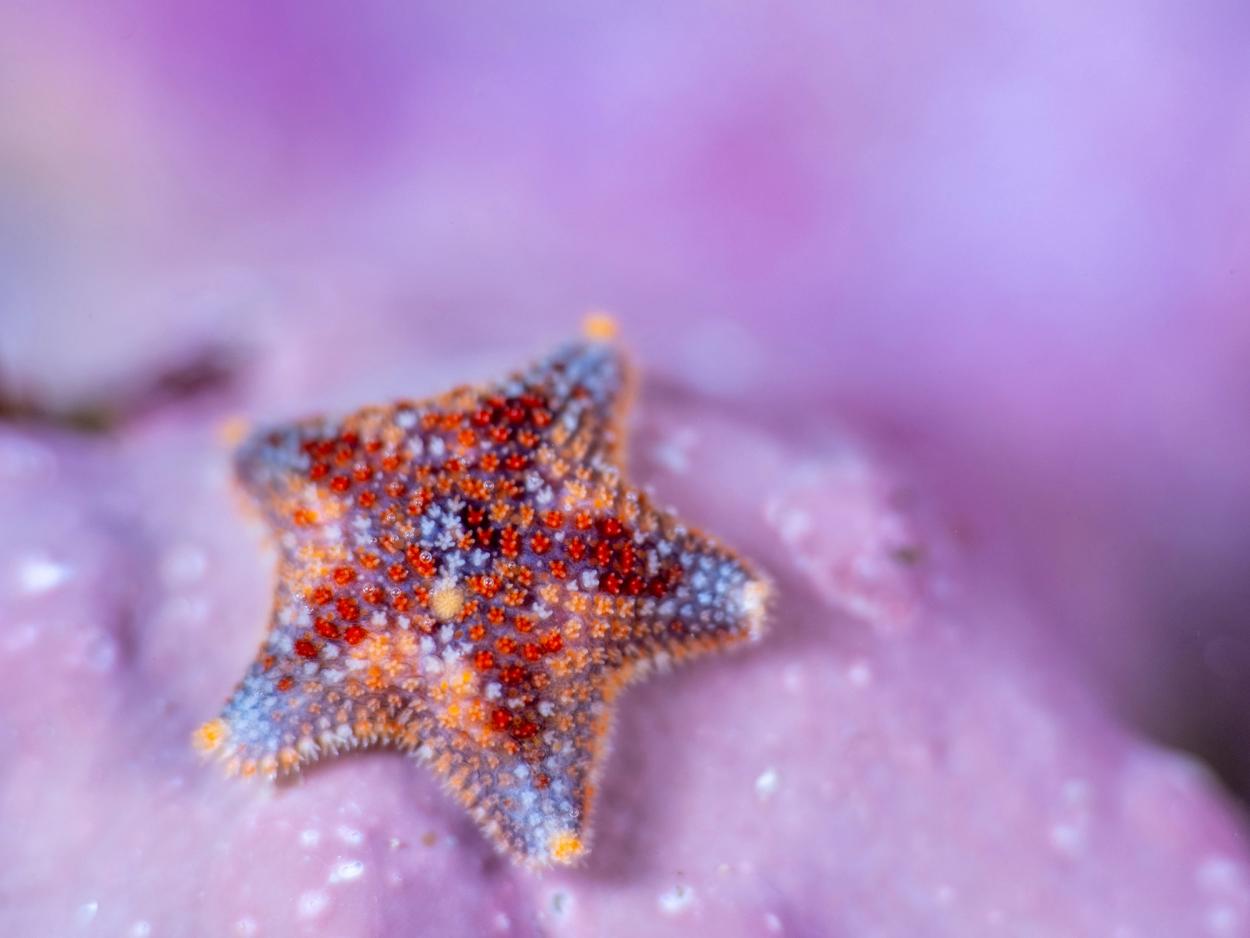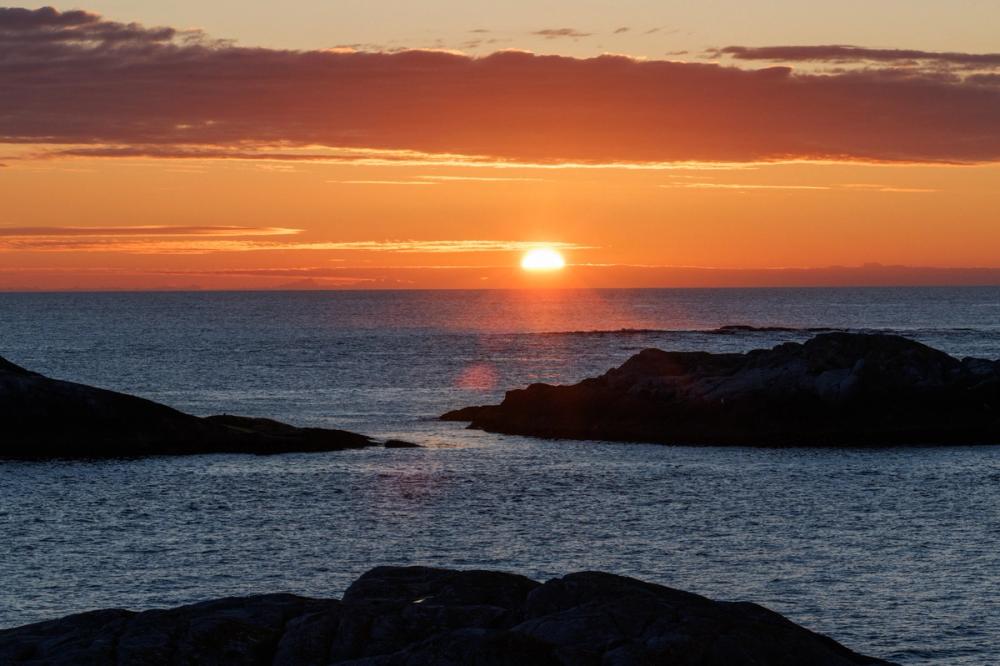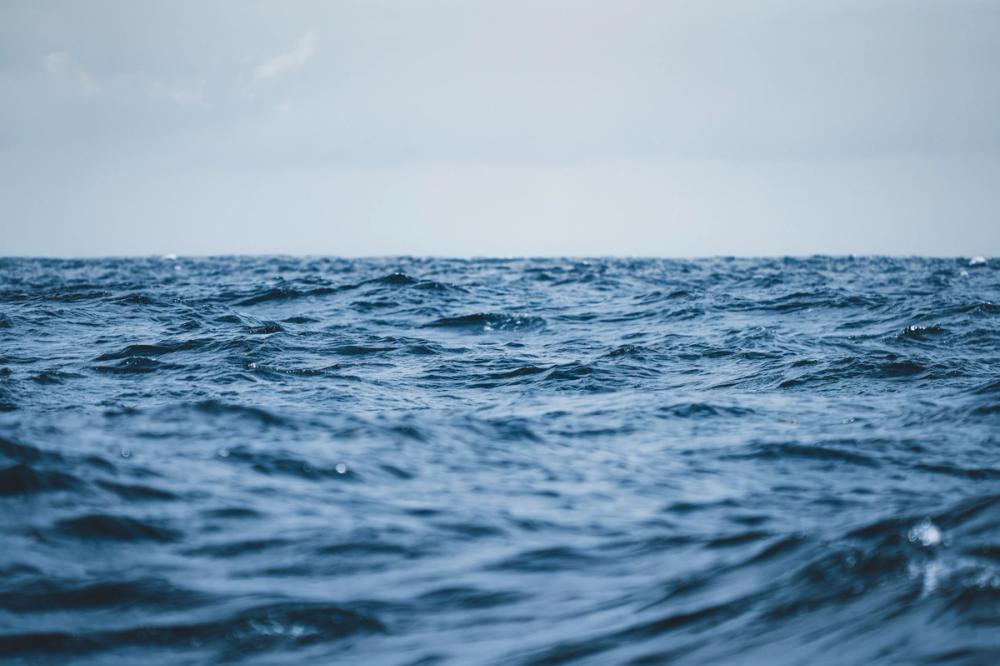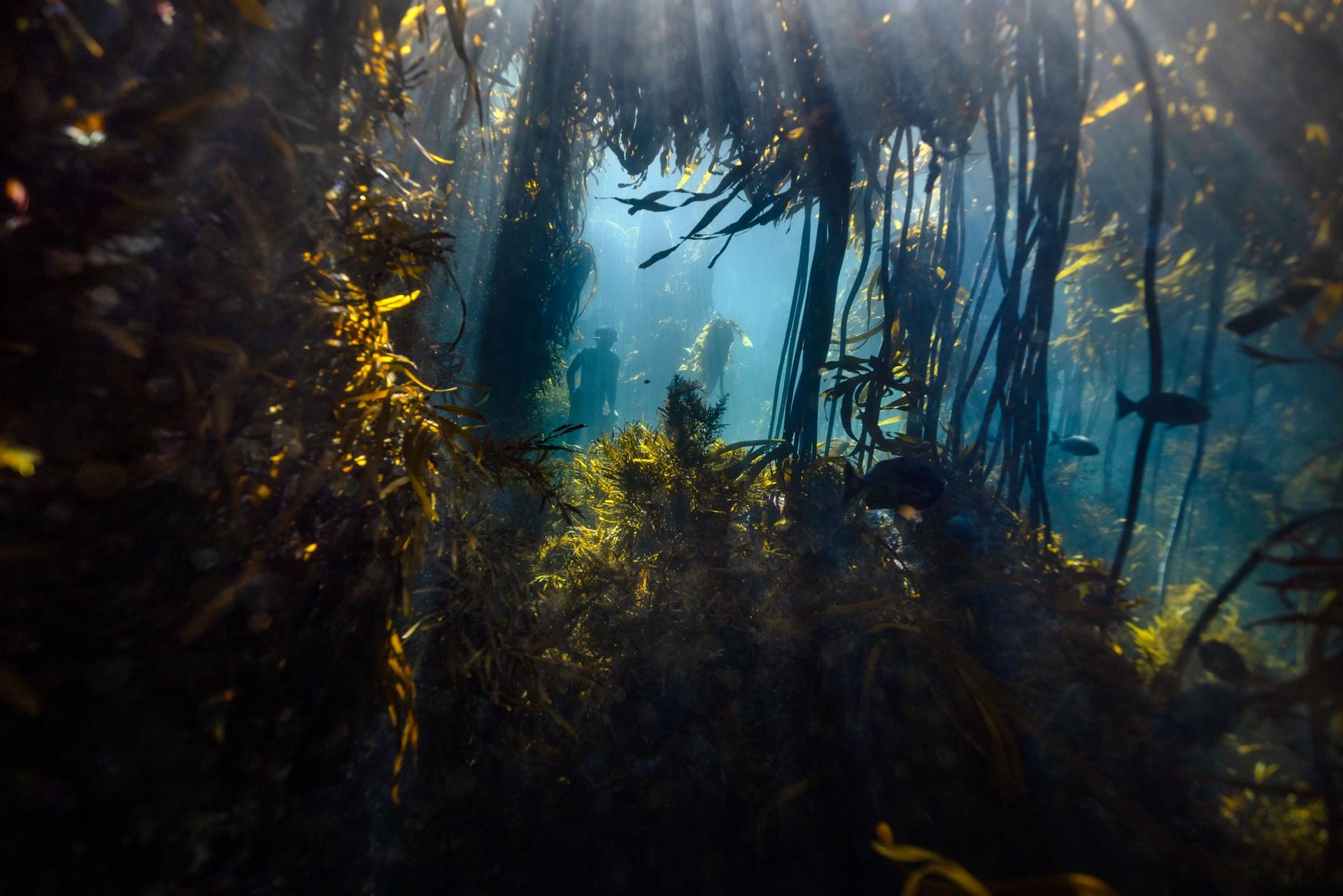
Blue forest bliss
The joy and sorrow of the ocean's hidden forests
Freediving in the underwater jungles of Cape Town, South Africa. @Aleksander Nordahl
11 February 2025
Suspended a few metres above the kelp I fill my lungs and dive headlong towards it. Strong fin kicks propel me down to the luminous fronds, a tangle of bronzed ribbons that blaze in the autumn light. Pushing through the loose canopy I reach for a kelp stem; as thick as a broom handle, this spar-like stipe holds the frond aloft towards the sunlight. Gripping on near the base I hold tight to counter the upward pull of my wetsuit’s buoyancy and notice how it feels rough in my hand. The surface is crowded with red seaweeds and furred with colonies of tiny animals, a habitat in itself. A claw-like holdfast fixes it to the rock using polysaccharides, sticky sugars that form a powerful adhesive bond. I am anchored too, swaying with the seaweed in the swell as I settle into the calm of this magical underwater forest.
Diving off the coast of Wales, I’m submerged in a tiny corner of the vast kelp forest ecosystem that thrives in cold temperate latitudes of the world's ocean. From the UK to Norway, South Africa, Japan, Australia and the Americas kelp forests are found along one-third of the world’s coastlines and are a type of blue forest. Providing habitat, oxygen, and carbon storage on a staggering scale, blue forests are the lifeblood of our ocean.

Hidden beneath cool Atlantic waters, a kelp forest off the Welsh coast. © Lou Luddington
The blue forest ecosystems: a vital force
The kelp forests of the UK coast may be modest compared to the towering jungles of giant kelp (Macrocystis pyrifera) of Australasia and the Americas or the stands of majestic sea bamboo (Ecklonia maxima) along South Africa’s coasts but they are no less vital. Like their terrestrial counterparts, these underwater forests are essential to life on Earth. Although kelp is not a tree, it plays the same crucial role in the ocean that forests do on land. It captures sunlight, absorbs carbon dioxide, and releases oxygen through photosynthesis, forming the foundation of the marine food web. Alongside seagrass meadows, mangrove swamps, salt marshes and seaweed gardens, kelp forests make up the blue forest. They are unique in their ability to capture and store vast amounts of carbon. This process, known as blue carbon sequestration, allows these ecosystems to absorb up to 10 times more carbon per hectare than terrestrial forests, locking it away in underwater sediments for hundreds of years. This makes blue forests one of the most effective natural solutions in the fight against climate change. But they do far more than sequester carbon. These vibrant ecosystems create and support an astonishing diversity of life, pump out oxygen, furnish us with food, resources and livelihoods, protect our coastlines from flooding and erosion, stabilise our climate and nourish our mental well-being. Our blue forests are the powerhouses of the ocean that we cannot do without. In the words of legendary oceanographer, deep sea explorer and field researcher:
No water, no life. No blue, no green.
- Dr Sylvia Earle
Autumn underwater: a season of transition
My freedive in the kelp is at summer's end when the water is still balmy from a season of sunshine. The kelp look shabby, abraded and overgrown, signs of imminent change and a shift towards autumn underwater. An invisible pulse of energy sweeps the ragged fronds one way, bending and flexing the stipes, then hauls them back the other. They flutter and billow in the flow like drapes in a blustering wind, as the surge pours through and over them. Honed by these forces they are made to move like water. Supple and yielding they orientate with the flow, stretching, twisting, eddying. In heavy seas, this is where their strength lies. No oak, pine or redwood tree could survive such ferocity on land.
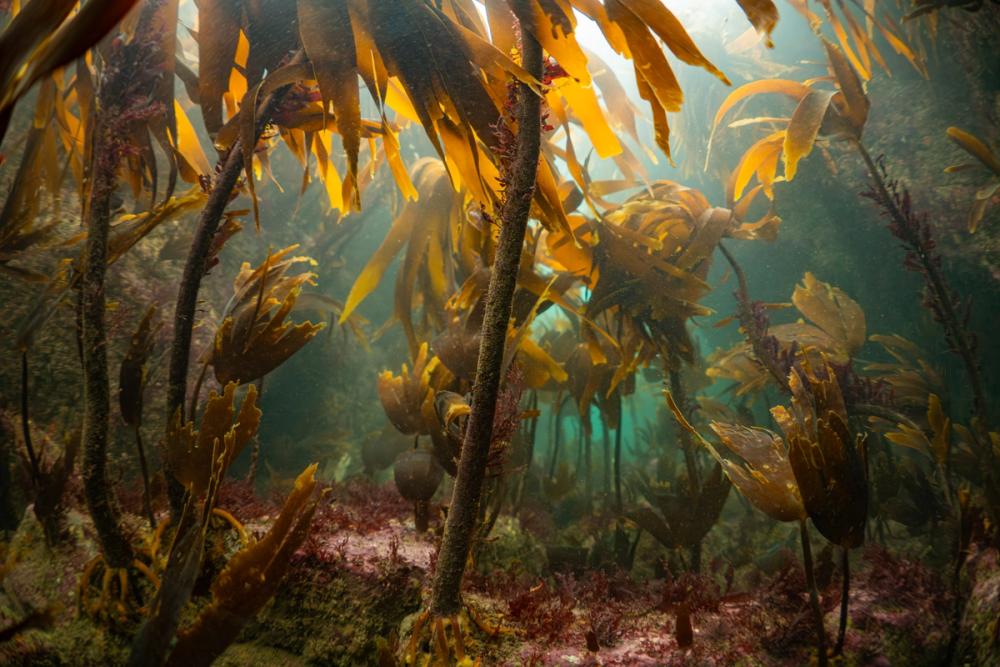
Beneath the canopy of northern kelp where a lush growth of understory life thrives in the shade. In autumn the ephemeral red seaweeds start to die back and the kelp look shabby and overgrown with epifauna, animals that grow on the kelp. © Lou Luddington
The annual lifecycle of furbellows (Saccorhiza polyschides) means their days are numbered. Gaunt and wave-ravaged, the fronds are etched with a meandering network of furrows, the grazing trails of blue-rayed limpets (Patella pellucida). These tiny herbivores use their many-toothed radula to bite chunks from the seaweed, speeding its demise. Grey top shells (Steromphala cineraria) another type of sea snail, dot the kelp fronds too. Instead of feasting on the kelp, they use their brush-like radula to sweep it clean of surface algae and sporelings to eat. By contrast, Northern kelp (Laminaria hyperborea), the perennial mainstay of these northeast Atlantic forests, may live for several years shedding their overgrown and ragged fronds in winter and early spring to make way for new growth. Once discarded they drift and sink or are wrecked on the shore forming a rich strandline habitat. Pulled apart by the forces of nature they are torn, mulched, dissolved, eaten, digested. Molecules that were once seaweed may become plankton, fish, seal, snail or bird, recycled into a new existence. This dynamic flow of nutrients, energy and resources fuels the ocean’s natural cycles, nourishing the next wave of life.
Biodiversity and sentience
Compared to the bustle of spring, it’s quiet in the autumn forest; I miss the hoards of gently pulsating sea jellies that cloud the water all summer long and lament the absence of spider crabs that have migrated back to deeper water. Territorial by nature ballan wrasse (Labrus bergylta) remain in residence, patrolling their patch among the kelp. I spot a chunky male, coloured amber to match the scene and greet him with a broad smile that lets a trickle of cold water into my dive mask. He looms closer eyeing me, then slips behind a curtain of tangled fronds. I wonder how the fish feels in my presence; studies have shown fishes to be sentient beings, capable of feeling joy, curiosity and fear (Balcombe, 2016). Acutely aware of their surroundings they are social, cunning and crafty, endearing traits they share with us.
These fleeting precious moments underwater lodge in my mind and hit heart-centre. They make me appreciate the importance of these cold water forests as rich habitats for fishes like the wrasse, and countless other species. Each kelp supports a community of life—mussels, crabs, starfish, and anemones all finding refuge among the fronds, stipe or holdfast. In a study of animals associated with a single northern kelp holdfast, scientists found 90 different species and 10,000 individuals living among its branches (Teagle et al., 2018). Yet, for all its vibrancy and vitality, this ecosystem is fragile and under threat.
Threats to the Blue Forests: A Hidden Crisis
The urge to breathe prompts me to release my grip on the kelp and I begin to rise. Relishing the sensation of weightless surrender I enjoy the slow ride back to the air, accelerating as I near the surface, then bobbing to an abrupt halt. Breathing at the bright interface between air and water I’m reminded how the blue forests of the world helped create the air that we breathe. Crafted from carbon dioxide, water and sea minerals, all the blue foresters are bound by their mastery of light. Everything they are has evolved to link the capture of light to the flourishing growth and a life-giving byproduct, oxygen.
Crafted from carbon dioxide, water and sea minerals, all the blue foresters are bound by their mastery of light.
Blue forest ecosystems are essential to maintaining the balance of the ocean. Their role in coastal protection, carbon storage, and biodiversity is vital but they face significant threats worldwide. Mangroves buffer shorelines and store large amounts of carbon but are being deforested for agriculture, aquaculture, and urban expansion, while also suffering from rising sea levels and temperature changes due to climate change (Duke et al., 2007, McLeod et al., 2011). Seagrass meadows, which provide nursery habitats for marine species and help stabilise sediments, are degraded by pollution, sedimentation, and physical destruction from coastal activities like dredging and anchoring and are particularly vulnerable to water quality and temperature shifts (Waycott et al., 2009, Kennedy et al., 2010).
Salt marshes, essential for flood protection and water filtration, are under pressure from coastal development, pollution, and altered tidal flows, with rising sea levels threatening to submerge them if they cannot keep pace (Barbier et al., 2011). Kelp forests and seaweed gardens support rich marine biodiversity and provide coastal protection. Both are under threat from warming ocean temperatures, pollution, trawling and overfishing of commercial species such as Atlantic cod (Gadus morhua), which are critical to controlling ravenous sea urchins that can overgraze kelp creating underwater deserts (Tegner and Dayton, 2000).
These ecosystems are all interconnected in their role in maintaining healthy coastal environments. Left intact and unexploited, their service as dynamic, thriving ecosystems is unequivocal. Around the world, scientists and conservationists are working to protect and restore these vital ecosystems, providing hope that we may reverse some of the ocean’s human-induced loss.
A path through the forest: compassion, reflection and action
The blue forest is a mighty collective, a union of ocean-bound primary producers that are the light-harvesting foundations of our planet without which all life would falter. To know this, to learn it or to remind oneself is an act of mindful pursuit and a first step towards caring for the ocean. In her poem “Messenger” Mary Oliver writes, “My work is loving the world… Let me keep my mind on what matters, which is my work, which is mostly standing still and learning to be astonished.”
At Reflections our work is loving the ocean and sharing what we see, so that others may learn to stand still and be astonished or outraged or conflicted. What happens next is up to you.
Join us as we discover the blue forest ecosystems, glide among their fronds, stems and branches, delve into the rich stories they hold, explore the lives and characters they’ve captivated, learn of their woes and perils, delights and superpowers, consider the science and art, deep connection and disconnection, use and misuse, loss and restoration and reflect on what the future holds for our human relationship with the blue forest.
Share this story
- Ecosystems and habitats
- Threats















